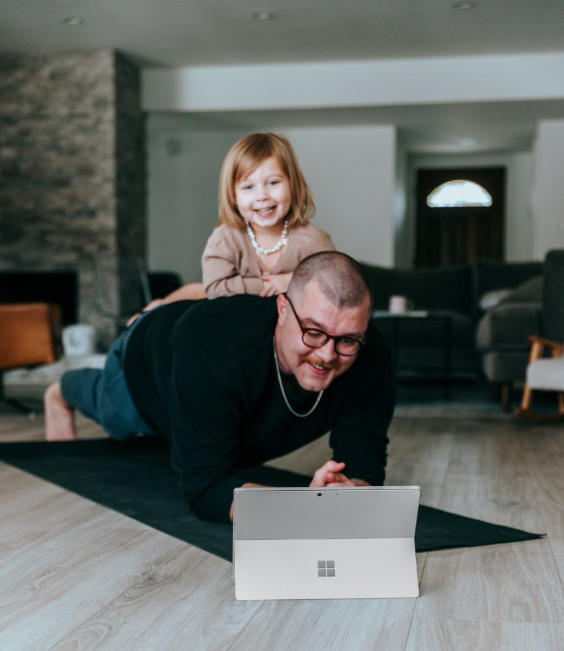(Members of the FAST Lab. From left to right: Eli Puterman, Jesper Pedersen, Naomi Maldonado-Rodriguez, Ben Hives, Brook Haight, Luke Peddie, Boaz Injege, Spencer Pratt, Hana Hicks, and Gunther the pup. Missing: Nathan Reis, Vincent Gosselin Boucher, Nicole Mazara, Joshua Webster, and Sierra Moores)
Throughout the pandemic, many took to exercise as a way to manage stress in an uncertain world.
However, many social activities – including exercise moved almost exclusively online for long periods when restrictions were in place.
What was the impact of this change?
Dr. Eli Puterman, Associate Professor at the University of British Columbia and Canada Research Chair, aimed to find out.

He wanted to measure the success of these virtual exercise options and if they could reduce depressive symptoms in adults.
He is recruiting for his biggest study yet: the COVID-19 Pandemic and Exercise for Health Care Workers Trial (COPE-HCW). This study, in partnership with Providence Health Care (PHC) aims to measure whether exercise can help reduce burnout symptoms in health care workers.
It is recruiting at least 500 participants, all of them Providence staff.
The Daily Scan sat down with Dr. Puterman to learn more about the research.
What is your background?
I’m a health psychologist and Associate Professor with the School of Kinesiology at UBC and I’m also a Canada Research Chair in Physical Activity and Health.
What is the purpose of your study?
The purpose of the study is to examine the extent to which becoming more physically active can improve the well being of health care workers over a three month period.
Tell me more about why you chose this topic in particular.
There is very wide evidence that exercise improves mental health, but when the pandemic hit, gyms closed and people were told to avoid the outdoors. In the early weeks of the pandemic, I saw an ad for this workout app, Down Dog, and started using it 4 or 5 times per week. I noticed that people around me were getting depressed and anxious, and were not being physically active, and I wondered “Oh, why is this not a research study? Like I’m feeling OK after I exercise; can others too?” We completed the trial two years ago with 350 adults from across Canada, with important findings on improved depression symptoms, and started turning our attention to more specific populations.
The study is expected to be complete in March 2023.
We began thinking, is there something that we can deliver to those health care workers at Providence Health Care who are currently physically less active? Can we deliver something to the population of health care workers to see whether we can improve health and well being through movement?
You’ve done studies with the general population before – how did that turn out?
Our last study showed that over a six-week period at the beginning of the pandemic, that exercise reduced depressive symptoms in approximately 350 Canadians. In the first few months of the pandemic, people’s depression, isolation, and threats to livelihood were high. We found that these Canadians who were self isolating and working from home, if they took 20 minutes, four times a week out of their lives to use these apps and move their bodies, that they had a significant reduction in the depressive symptoms.
As a researcher and health psychologist I’m excited by the potential of these results, especially since the participants who gained the most were the ones who had the highest level of depressive symptoms at the start of the study. What it tells me is that we can potentially impact the wellbeing of other individuals hit hard by the pandemic. Growing research is telling us that health care workers have been some of the hardest hit people during the pandemic, with higher rates of depression, anxiety, and burnout that the rest of the population. This not only impacts the wellbeing of the provider, but impacts the care provided to the recipient, and impact their families. If we can improve the wellbeing of health care workers, perhaps this may eventually translate to how health care workers interact with people, and the kind of care that they can provide.
What are some outcomes you’re hoping to see in this trial?
This has amazing potential for impacting a whole health care system. If we can show over a 12 week period that there are things that people can do within themselves, that can potentially improve their own health and wellbeing as we wait for the healthcare system to improve, maybe this type of program can be something that health authorities can offer to their staff. Perhaps a collaboration can happen between health care organizations and different wellness apps to provide free access for their staff. Of course, it’s not the only solution to health and well being concerns of healthcare workers, but it’s potentially one solution.
What made you decide to partner with Down Dog?
When I started using Down Dog during the early weeks of the pandemic, I found that it completely changed my enjoyment of working out with an app – it went from every workout being almost the same to a unique, randomized experience.

You press a button, and from there you can change the length, the intensity, body area of focus, voiceover, use of weights or bands, and the model, to name a few of the unique features of Down Dog. After choosing the length of time for the workout and breaks in between movements, it pulls and creates a video that is completely unique each and every time with those parameters from their library. And now they’ve incorporated even more layers of diversity and I just love that every single workout will be a different experience for different parts of my body.
What are some final thoughts you have about this study, and for burnout in general?
It’s great to help people to get moving, but some people are having a hard time keeping it going. We may need to help them even more. We have to give more incentive, more reasons to, more emotional support, more social support, and part of my goal is to start creating those systems after this study. A big goal for the current study is to understand who will participate, how often will they use the suite of apps, and what was their level of enjoyment of the apps, so that we can learn how to refine a more individualized approach to supporting health care workers to move their bodies in future studies, if needed.





